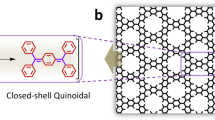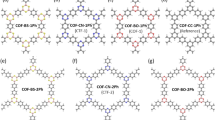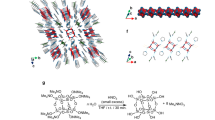Abstract
This focus review describes several methods for aligning π-electronic systems to achieve various functionalities in both solution and the solid phase. Cyclic oligomers, acting as tethering units, can facilitate precise design of the nanoarchitecture of π-electronic systems. This approach produces three-dimensionally aligned structures of π-electronic systems in diluted solutions, where the intermolecular interactions are partially excluded. In the solid state, charged π-electronic systems exhibit nanoarchitectures based on electrostatic interactions, including the repulsive and attractive forces generated between the identically charged and differently charged species, respectively. These methods for controlling the arrangements of π-electronic systems can produce fascinating molecular systems.
This is a preview of subscription content, access via your institution
Access options
Subscribe to this journal
Receive 12 print issues and online access
$259.00 per year
only $21.58 per issue
Buy this article
- Purchase on Springer Link
- Instant access to full article PDF
Prices may be subject to local taxes which are calculated during checkout





Similar content being viewed by others
References
Hunter CA, Sanders JKM. The nature of π-π interactions. J Am Chem Soc. 1990;112:5525–34.
Meller G, Grasser T, editors. Organic electronics. Berlin: Springer; 2009.
Samori P, Cacialli F, editors. Functional supramolecular architectures. Weinheim: Wiley-VCH; 2011.
Binnemans K. Ionic liquid crystals. Chem Rev. 2005;105:4148–204.
Kato T, Mizoshita N, Kishimoto K. Functional liquid-crystalline assemblies: self-organized soft materials. Angew Chem Int Ed. 2006;45:38–68.
Faul CF. Ionic self-assembly for functional hierarchical nanostructured materials. Acc Chem Res. 2014;47:3428–38.
Goossens K, Lava K, Bielawski CW, Binnemans K. Ionic liquid crystals: versatile materials. Chem Rev. 2016;116:4643–807.
Ikeda A, Shinkai S. Novel cavity design using Calix[n]arene skeletons: toward molecular recognition and metal binding. Chem Rev. 1997;97:1713–34.
Hippius C, Van Stokkum IHM, Gsänger M, Groeneveld MM, Williams RM, Würthner F. Sequential FRET processes in calix[4]arene-linked orange-red-green perylene bisimide dye zigzag arrays. J Phys Chem C. 2008;112:2476–86.
Ogoshi T, Yamagishi T, Nakamoto Y. Pillar-shaped macrocyclic hosts pillar[n]arenes: new key players for supramolecular chemistry. Chem Rev. 2016;116:7937–8002.
Ogoshi T, Umeda K, Yamagishi T, Nakamoto Y. Through-space pi-delocalized Pillar[5]arene. Chem Commun. 2009;4874–6.
Azumaya I, Kagechika H, Yamaguchi K, Shudo K. Facile formation of aromatic cyclic N-methylamides based on cis conformational preference. Tetrahedron Lett. 1996;37:5003–6.
Azumaya I, Okamoto T, Imabeppu F, Takayanagi H. Simple and convenient synthesis of tertiary benzanilides using dichlorotriphenylphosphorane. Tetrahedron. 2003;59:2325–31.
Imabeppu F, Katagiri K, Masu H, Kato T, Tominaga M, Therrien B, Takayanagi H, Kaji E, Yamaguchi K, Kagechika H, Azumaya I. Calix[3]amides—bowl-shaped cyclic trimers toward building block for molecular recognition: self-complementary dimeric structure in the crystal. Tetrahedron Lett. 2006;47:413–6.
Kakuta H, Azumaya I, Masu H, Matsumura M, Yamaguchi K, Kagechika H, Tanatani A. Cyclic-tri(N-methyl-meta-benzamide)s: substituent effects on the bowl-shaped conformation in the crystal and solution states. Tetrahedron. 2010;66:8254–60.
Takagi K, Sugimoto S, Yamakado R, Nobuke K. Self-assembly of oligothiophene chromophores by m-calix[3]amide scaffold. J Org Chem. 2011;76:2471–8.
Yamakado R, Sugimoto S, Matsuoka S, Suzuki M, Funahashi Y, Takagi K. Preparation of molecular cage by coordination of m-calix[3]amide bearing pyridine with palladium complex. Chem Lett. 2012;41:249–51.
Yamakado R, Matsuoka S, Suzuki M, Takagi K, Katagiri K, Azumaya I. A screw-shaped alignment of pyrene using m-calix[3]amide. Tetrahedron. 2013;69:1516–20.
Masu H, Katagiri K, Kato T, Kagechika H, Tominaga M, Azumaya I. Chiral spherical molecule constructed from aromatic amides: facile synthesis and highly ordered network structure in the crystal. J Org Chem. 2008;73:5143–6.
Fujimoto N, Matsumura M, Azumaya I, Nishiyama S, Masu H, Kagechika H, Tanatani A. Molecular chirality and chiral capsule-type dimer formation of cyclic triamides via hydrogen-bonding interactions. Chem Commun. 2012;48:4809–11.
Yamakado R, Mikami K, Takagi K, Azumaya I, Sugimoto S, Matsuoka S, Suzuki M, Katagiri K, Uchiyama M, Muranaka A. Helicity induction in three pi-conjugated chromophores by planar chirality of calixamide. Chem Eur J. 2013;19:11853–7.
Saito Y, Satake M, Mori R, Okayasu M, Masu H, Tominaga M, Katagiri K, Yamaguchi K, Kikkawa S, Hikawa H, Azumaya I. Synthesis and chiroptical properties of cylindrical macrocycles comprising two calix[3]aramide moieties. Org Biomol Chem. 2020;18:230–6.
Yamakado R, Matsuoka S, Suzuki M, Takeuchi D, Masu H, Azumaya I, Takagi K. Diastereoselective cyclization of an aminobenzoic acid derivative and chiroptical properties of triple-stranded helical bis(phenylethynyl)benzene. Chem Commun. 2015;51:5710–3.
Goff EL, Lacount RB. Some charge-transfer salts of 1,2,3,4,5-pentacarbomethoxycyclopentadienyl anion. J Am Chem Soc. 1963;85:1354–5.
Bruce MI, Humphrey PA, Skelton BW, White AH. Pentakis(methoxycarbonyl)-cyclopentadiene chemistry. X. Crystal-structure of the charge-transfer complex tropylium pentakis(methoxycarbonyl)cyclopentadienide. Aust J Chem. 1986;39:165–9.
Jayanty S, Radhakrishnan TP. ‘Core and sheath’ structure of a TTF complex forming a square grid. J Mater Chem. 1999;9:1707–11.
Webster OW. Diazotetracyanocyclopentadiene and its conversion to tetracyanocyclopentadienide and pentacyanocyclopentadienide. J Am Chem Soc. 1965;87:1820–1.
Sakai T, Seo S, Matsuoka J, Mori Y. Synthesis of functionalized tetracyanocyclopentadienides from tetracyanothiophene and sulfones. J Org Chem. 2013;78:10978–85.
Richardson C, Reed CA. Exploration of the pentacyano-cyclo-pentadienide ion, C5(CN)5-, as a weakly coordinating anion and potential superacid conjugate base. Silylation and protonation. Chem Commun. 2004;706–7.
Less RJ, Mcpartlin M, Rawson JM, Wood PT, Wright DS. A simple approach to coordination compounds of the pentacyanocyclopentadienide anion. Chem Eur J. 2010;16:13723–8.
Bando Y, Haketa Y, Sakurai T, Matsuda W, Seki S, Takaya H, Maeda H. Ion-pairing assemblies based on pentacyano-substituted cyclopentadienide as a pi-electronic anion. Chem Eur J. 2016;22:7843–50.
Ino I, Zhong JC, Munakata M, Kuroda-Sowa T, Maekawa M, Suenaga Y, Kitamori Y. 2-D interwoven and 3-D 5-fold interpenetrating silver(i) complexes of 1-(isocyanidomethyl)-1H-benzotriazole and 1,3-bis(dicyanomethylidene)indan. Inorg Chem. 2000;39:4273–9.
Son Y, Kim S. New pH indicator based on 1,3-bisdicyanovinylindane. Dyes Pigments. 2005;64:153–5.
Fujisawa J-i. An unusual mechanism for HOMO–LUMO gap narrowing in a minimal near-IR dye generated by the deprotonation of bis(dicyanomethylene)indan. Chem Phys Lett. 2014;608:355–9.
Tanaka Y, Ichijo K, Kodama S, Aoyama S, Yoshida T, Yamakado R, Okada S. Various ionic crystals from the combination of 1,3-bis(dicyanomethylidene)indan anion and π-electronic cations. Cryst Growth Des. 2019;19:5811–8.
Maeda H, Fukui A, Yamakado R, Yasuda N. Dipyrrolyphenol as a precursor of π-electronic anion that forms ion pairs with cations. Chem Commun. 2015;51:17572–5.
Yamakado R, Ishibashi H, Motoyoshi Y, Yasuda N, Maeda H. Ion-pairing assemblies based on π-extended dipyrrolylquinoxalines. Chem Commun. 2019;55:326–9.
Haketa Y, Maeda H. Dimension-controlled ion-pairing assemblies based on pi-electronic charged species. Chem Commun. 2017;53:2894–909.
Haketa Y, Maeda H. Dimension-controlled π-electronic ion-pairing assemblies. Bull Chem Soc Jpn. 2018;91:420–36.
Yamakado R, Sakurai T, Matsuda W, Seki S, Yasuda N, Akine S, Maeda H. π-Electron systems that form planar and interlocked anion complexes and their ion-pairing assemblies. Chem Eur J. 2016;22:626–38.
Yamakado R, Maeda H. Ion-pairing assemblies of photoresponsive cations and an interlocked [2 + 1]-type π-system-anion complex. J Photochem Photobiol A Chem. 2016;331:215–23.
Yamakado R, Sato R, Shigeta Y, Maeda H. Ion-pairing crystal polymorphs of interlocked [2 + 1]-type receptor-anion complexes. J Org Chem. 2016;81:8530–6.
Yamakado R, Ashida Y, Sato R, Shigeta Y, Yasuda N, Maeda H. Cooperatively interlocked [2 + 1]-type π-system-anion complexes. Chem Eur J. 2017;23:4160–8.
Laursen BW, Krebs FC. Synthesis of a triazatriangulenium salt. Angew Chem Int Ed. 2000;39:3432–4.
Laursen B W, Krebs F C. Synthesis, structure, and properties of azatriangulenium salts. Chem Eur J. 2001;7:1773–83.
Acknowledgements
The author expresses gratitude to all his colleagues for their valuable contributions to this focus review. The author is deeply indebted to Prof. Shuji Okada (Yamagata University), Prof. Hiromitsu Maeda (Ritsumeikan University), and Prof. Koji Takagi (Nagoya Institute of Technology) for continuous encouragement and constructive discussions. This research was partly supported by the Grants-in-Aid for Scientific Research on Innovation Areas (“Photosynergetics” Area 2606, No. JP26107007) from the MEXT.
Author information
Authors and Affiliations
Corresponding author
Ethics declarations
Conflict of interest
The author declares no conflict of interest.
Additional information
Publisher’s note Springer Nature remains neutral with regard to jurisdictional claims in published maps and institutional affiliations.
Rights and permissions
About this article
Cite this article
Yamakado, R. Well-defined arrangement of π-electronic systems based on precise molecular design. Polym J 52, 701–708 (2020). https://doi.org/10.1038/s41428-020-0338-5
Received:
Revised:
Accepted:
Published:
Issue Date:
DOI: https://doi.org/10.1038/s41428-020-0338-5



